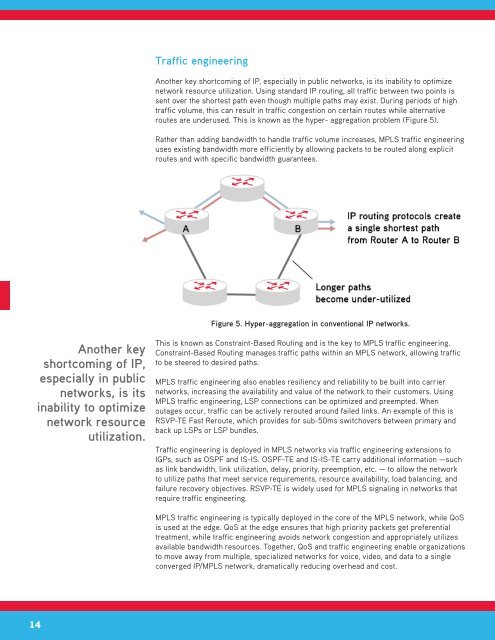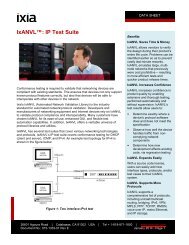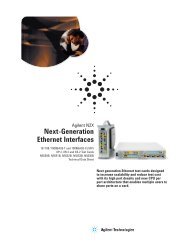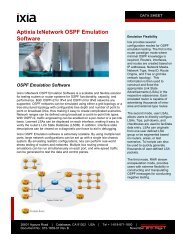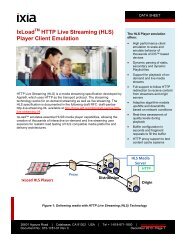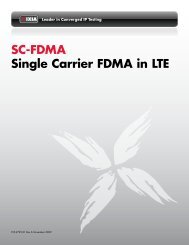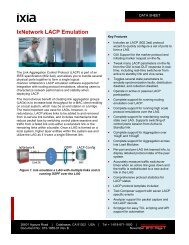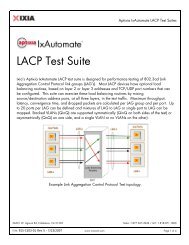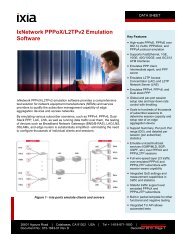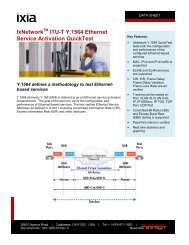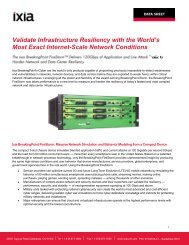Multi-Protocol Label Switching (MPLS) Conformance and ... - Ixia
Multi-Protocol Label Switching (MPLS) Conformance and ... - Ixia
Multi-Protocol Label Switching (MPLS) Conformance and ... - Ixia
You also want an ePaper? Increase the reach of your titles
YUMPU automatically turns print PDFs into web optimized ePapers that Google loves.
Traffic engineeringAnother key shortcoming of IP, especially in public networks, is its inability to optimizenetwork resource utilization. Using st<strong>and</strong>ard IP routing, all traffic between two points issent over the shortest path even though multiple paths may exist. During periods of hightraffic volume, this can result in traffic congestion on certain routes while alternativeroutes are underused. This is known as the hyper- aggregation problem (Figure 5).Rather than adding b<strong>and</strong>width to h<strong>and</strong>le traffic volume increases, <strong>MPLS</strong> traffic engineeringuses existing b<strong>and</strong>width more efficiently by allowing packets to be routed along explicitroutes <strong>and</strong> with specific b<strong>and</strong>width guarantees.Figure 5. Hyper-aggregation in conventional IP networks.Another keyshortcoming of IP,especially in publicnetworks, is itsinability to optimizenetwork resourceutilization.This is known as Constraint-Based Routing <strong>and</strong> is the key to <strong>MPLS</strong> traffic engineering.Constraint-Based Routing manages traffic paths within an <strong>MPLS</strong> network, allowing trafficto be steered to desired paths.<strong>MPLS</strong> traffic engineering also enables resiliency <strong>and</strong> reliability to be built into carriernetworks, increasing the availability <strong>and</strong> value of the network to their customers. Using<strong>MPLS</strong> traffic engineering, LSP connections can be optimized <strong>and</strong> preempted. Whenoutages occur, traffic can be actively rerouted around failed links. An example of this isRSVP-TE Fast Reroute, which provides for sub-50ms switchovers between primary <strong>and</strong>back up LSPs or LSP bundles.Traffic engineering is deployed in <strong>MPLS</strong> networks via traffic engineering extensions toIGPs, such as OSPF <strong>and</strong> IS-IS. OSPF-TE <strong>and</strong> IS-IS-TE carry additional information —suchas link b<strong>and</strong>width, link utilization, delay, priority, preemption, etc. — to allow the networkto utilize paths that meet service requirements, resource availability, load balancing, <strong>and</strong>failure recovery objectives. RSVP-TE is widely used for <strong>MPLS</strong> signaling in networks thatrequire traffic engineering.<strong>MPLS</strong> traffic engineering is typically deployed in the core of the <strong>MPLS</strong> network, while QoSis used at the edge. QoS at the edge ensures that high priority packets get preferentialtreatment, while traffic engineering avoids network congestion <strong>and</strong> appropriately utilizesavailable b<strong>and</strong>width resources. Together, QoS <strong>and</strong> traffic engineering enable organizationsto move away from multiple, specialized networks for voice, video, <strong>and</strong> data to a singleconverged IP/<strong>MPLS</strong> network, dramatically reducing overhead <strong>and</strong> cost.14


